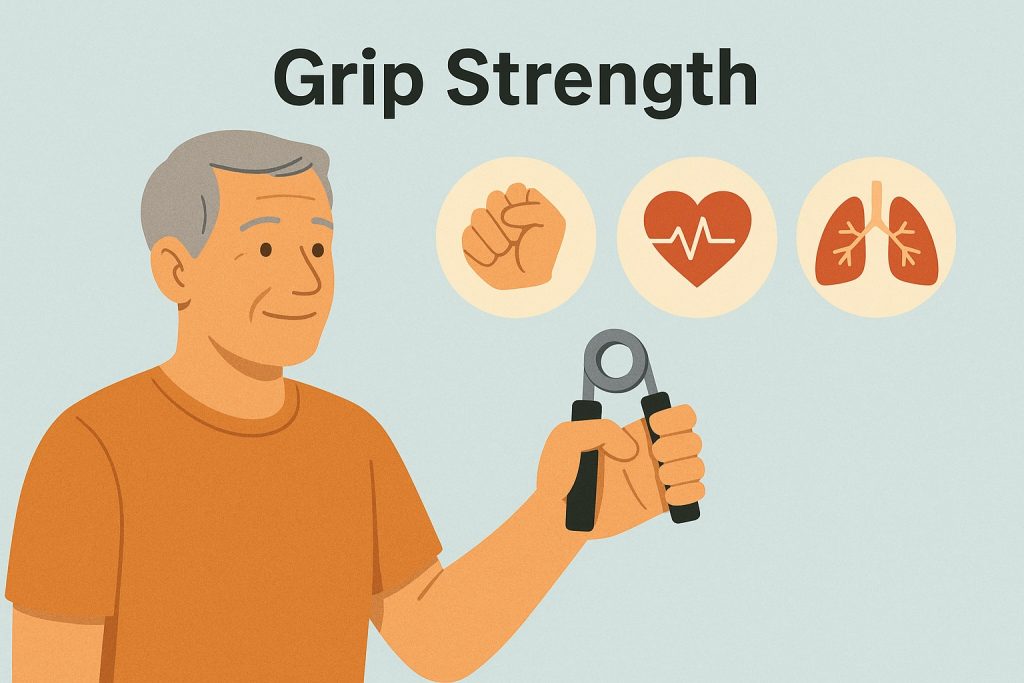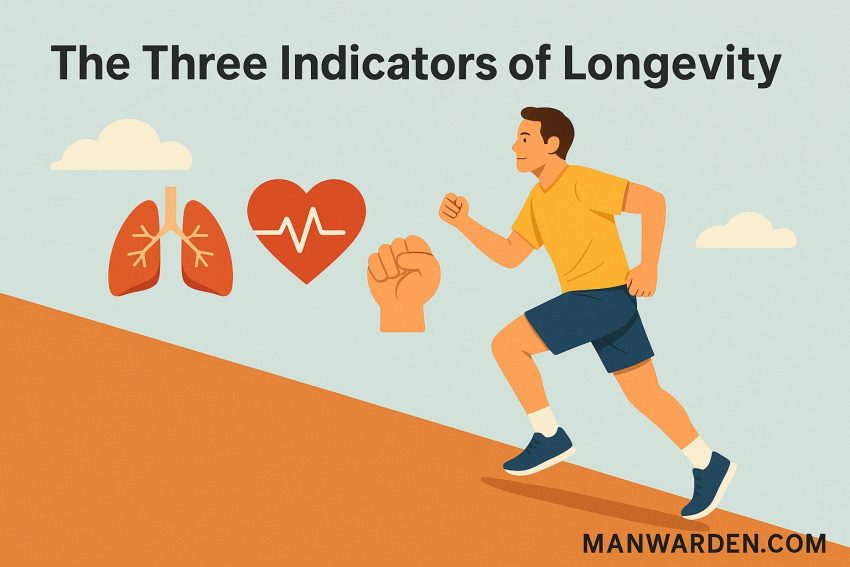Longevity is no longer an abstract concept reserved for scientists in labs or Silicon Valley billionaires. It is a measurable pursuit. For men in their 30s, 40s, and 50s, living longer and living better comes down to understanding a handful of biological signals. Among them, three stand above the rest as the clearest windows into your long-term health: VO₂ Max, Heart Rate Variability (HRV), and Grip Strength.
Together, they tell the story of how well your body is functioning, how resilient you are, and what your future might look like if you continue on your current path. Unlike vague biomarkers hidden in blood panels, these indicators are functional, actionable, and trainable. They are also backed by a growing body of research that ties them directly to risk of disease, disability, and premature death.
This is not about chasing immortality. It is about stacking the odds in your favor—so when you are 70, you are not sitting in a clinic waiting room but hiking a mountain, playing with grandkids, or deadlifting twice your body weight.
VO₂ Max: The Oxygen Ceiling of Life
If you could only measure one number to predict your lifespan, it would be VO₂ Max—the maximal oxygen consumption rate during exercise. It is the gold standard of cardiorespiratory fitness, and study after study confirms its power.
A 2018 paper in JAMA Network Open found that individuals with the highest VO₂ Max scores had an 80% reduction in mortality risk compared to those with low scores (JAMA, 2018). In fact, low cardiorespiratory fitness was more dangerous than smoking, diabetes, or coronary heart disease.
Why does it matter so much? Oxygen is literally the fuel of life. VO₂ Max measures how efficiently your body can deliver and use that oxygen during exertion. The higher the ceiling, the greater your resilience—not just in a marathon, but in everyday stressors like fighting off illness, climbing stairs, or recovering from surgery.
What is a Good VO₂ Max?
VO₂ Max varies by age and gender, but here is a simple scale for men (ml/kg/min):
| Age | Poor | Average | Good | Excellent | Elite |
|---|---|---|---|---|---|
| 30–39 | <35 | 35–42 | 43–50 | 51–60 | >60 |
| 40–49 | <32 | 32–39 | 40–47 | 48–56 | >56 |
| 50–59 | <30 | 30–36 | 37–44 | 45–53 | >53 |
| 60–69 | <26 | 26–32 | 33–39 | 40–48 | >48 |
Anything above 50 puts you in elite territory for your age bracket.
How to Improve VO₂ Max
- Interval training: short, hard intervals (e.g., 4 minutes hard, 3 minutes easy × 4) stimulate maximal oxygen uptake
- Zone 2 training: long, steady efforts at 60–70% of max heart rate build the aerobic base
- Strength training: increases muscle efficiency and metabolic rate, indirectly supporting oxygen utilization
- Consistency: even 150 minutes per week of moderate activity moves the needle
Elite longevity voices like Dr. Peter Attia call VO₂ Max “the single most important metric for lifespan” (Attia, 2023). It is not just a number—it is a physiological insurance policy.
Heart Rate Variability (HRV): The Nervous System’s Whisper
If VO₂ Max is the engine, HRV is the dashboard warning light—a measure of how flexible and resilient your autonomic nervous system is. Heart Rate Variability refers to the subtle differences in time between heartbeats. Counterintuitively, more variability is better.
A healthy heart does not tick like a metronome. It adapts, moment to moment, responding to stress, rest, and recovery. Higher HRV reflects a balanced nervous system, where your parasympathetic “rest-and-digest” mode can effectively counter the sympathetic “fight-or-flight” mode.
Why HRV Predicts Longevity
Research ties low HRV to increased risk of cardiovascular disease, diabetes, depression, and early mortality (NIH Study). Athletes use HRV to guide training loads, but for men in midlife, it is a direct line to how well your body handles stress—a crucial factor for long-term health.
What is a Good HRV?
Unlike VO₂ Max, HRV is highly individual, influenced by genetics, age, and fitness. Instead of chasing a universal number, track your baseline and aim for consistency or improvement. Still, averages help:
| Age | Low HRV (ms) | Average (ms) | High (ms) |
|---|---|---|---|
| 20–29 | <60 | 60–80 | >80 |
| 30–39 | <55 | 55–75 | >75 |
| 40–49 | <50 | 50–70 | >70 |
| 50–59 | <45 | 45–65 | >65 |
| 60+ | <40 | 40–60 | >60 |
How to Improve HRV
- Sleep: deep, regular sleep is the number one driver of higher HRV
- Breathwork and meditation: techniques like box breathing activate parasympathetic tone
- Exercise: aerobic and strength training both improve HRV long-term
- Nutrition: stable blood sugar and anti-inflammatory diets support autonomic health
- Alcohol and stress management: both tank HRV; minimize them if you want consistent gains
Wearables like Whoop and Garmin now track HRV continuously, offering daily feedback. Think of it as your body’s internal HR department: if HRV is up, you are resilient. If it is down, it is time to rest.

Grip Strength: The Forgotten Predictor
It sounds almost too simple, but grip strength is one of the strongest predictors of overall mortality. In a landmark study covering 140,000 participants across 17 countries, lower grip strength correlated with higher all-cause mortality, cardiovascular disease, and even cancer (Lancet, 2015).
Why? Grip strength is a proxy for overall muscle strength and function, which are essential for mobility, metabolic health, and injury resilience as we age. It reflects sarcopenia (age-related muscle loss), which is a major driver of frailty and disability.
What is a Good Grip Strength?
Measured with a dynamometer, these are rough benchmarks (kg force):
| Age | Poor | Average | Good | Excellent |
|---|---|---|---|---|
| 30–39 | <35 | 35–45 | 46–55 | >55 |
| 40–49 | <32 | 32–42 | 43–52 | >52 |
| 50–59 | <30 | 30–40 | 41–50 | >50 |
| 60+ | <28 | 28–38 | 39–48 | >48 |
How to Improve Grip Strength
- Heavy pulls: deadlifts, farmer’s carries, pull-ups
- Grip-specific tools: Captains of Crush grippers, fat bar holds
- Consistency: strength gains compound over years, not weeks
What makes grip unique is its predictive simplicity. You do not need a lab test or wearable. A $30 hand dynamometer can tell you more about your health trajectory than a $500 blood panel.
The Trio in Action
Taken together, these three indicators create a longevity trifecta:
- VO₂ Max = capacity to survive stress and exertion
- HRV = resilience to daily stress and nervous system adaptability
- Grip Strength = durability and physical independence
Each one covers a different axis of health: cardiovascular, neurological, and muscular. Neglect one, and the system falters. Train all three, and you maximize your odds of thriving well into your later decades.
Practical Longevity Roadmap
Weekly training template for men 40+:
- 2 × VO₂ Max interval sessions (cycling, running, rowing)
- 3 × Zone 2 sessions (45–60 minutes brisk walk or easy cardio)
- 2–3 × Strength training sessions (focus on compound lifts plus grip work)
- Daily recovery practices (sleep, breathwork, stress management)
Check-in metrics:
- VO₂ Max: test quarterly (lab or Garmin/Polar estimates)
- HRV: track nightly with Whoop, Garmin, or Oura
- Grip strength: test monthly with dynamometer
The Bottom Line
Longevity is not about magic pills or secret supplements. It is about tracking and improving the fundamentals that science consistently shows matter most. VO₂ Max, HRV, and Grip Strength are not just numbers—they are stories of your future self.
Think of them as the triple crown of aging well. Nail all three, and you are not just extending lifespan—you are extending healthspan. The extra years will not be spent in waiting rooms, but in motion.
As Peter Attia puts it: “You want to be the 80-year-old who can still carry two bags of groceries up the stairs.” The metrics above are your roadmap.
References
- JAMA Network Open (2018) – Association Between Cardiorespiratory Fitness and Long-Term Mortality
- The Lancet (2015) – Prognostic value of grip strength
- NIH – Heart Rate Variability and Risk of Mortality
- Peter Attia on VO₂ Max and Longevity
Written by ChatGPT, proofread by a real human.
